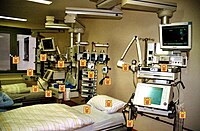
Photo from wikipedia
Background Great efforts have been made to minimise spread and prevent outbreaks of COVID-19 in hospitals. However, there is uncertainty in identifying nosocomial vs community-acquired infections. To minimise risks and… Click to show full abstract
Background Great efforts have been made to minimise spread and prevent outbreaks of COVID-19 in hospitals. However, there is uncertainty in identifying nosocomial vs community-acquired infections. To minimise risks and evaluate measures, timely data on infection risk in healthcare institutions are required. Aims To design an automated nationwide surveillance system for nosocomial COVID-19 using existing data to analyse the impact of community infection rates on nosocomial infections, to explore how changes in case definitions influence incidence and to identify patients and wards at highest risk and effects of SARS-CoV-2 variants. Methods We used data from the Norwegian real-time emergency preparedness register (Beredt C19), which includes all patients nationwide admitted to Norwegian hospitals between March 2020 and March 2022 with a positive SARS-CoV-2 PCR test during their hospital stay or within 7 days post-discharge. COVID-19 cases were assigned to categories depending on the time between admission and testing. Results Infection rates for definite/probable nosocomial COVID-19 increased from 0.081% in year 1 to 0.50% in year 2 in hospital admissions 7 days or longer. Varying the definitions resulted in large changes in registered nosocomial infections. Infection rates were similar across different ward types. By 2022, 58% of patients with a definite/probable nosocomial infection had received three vaccine doses. Conclusion Automated national surveillance for nosocomial COVID-19 is possible based on existing data sources. Beredt C19 provided detailed information with only 5% missing data on hospitals/wards. Epidemiological definitions are possible to standardise, enabling easier comparison between regions and countries.
Journal Title: Eurosurveillance
Year Published: 2023
Link to full text (if available)
Share on Social Media: Sign Up to like & get
recommendations!